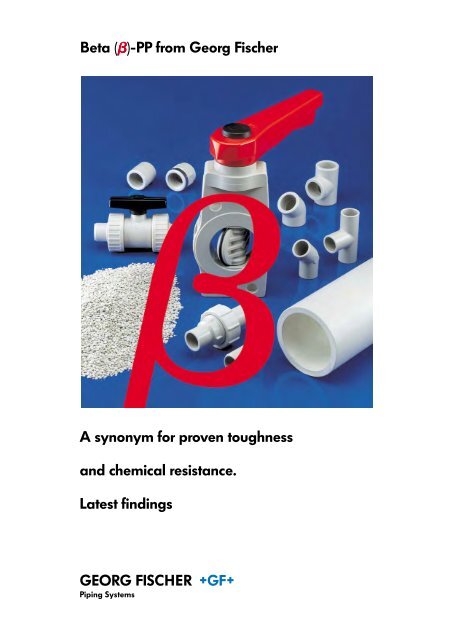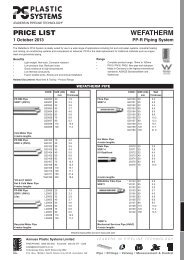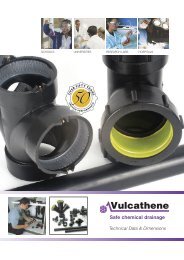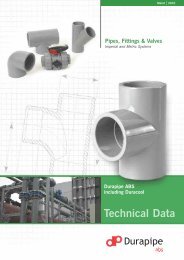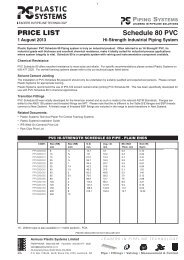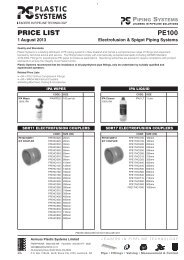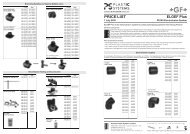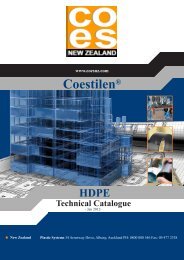Beta (b)-PP from Georg Fischer A synonym for ... - Plastic Systems
Beta (b)-PP from Georg Fischer A synonym for ... - Plastic Systems
Beta (b)-PP from Georg Fischer A synonym for ... - Plastic Systems
Create successful ePaper yourself
Turn your PDF publications into a flip-book with our unique Google optimized e-Paper software.
<strong>Beta</strong> (b)-<strong>PP</strong> <strong>from</strong> <strong>Georg</strong> <strong>Fischer</strong><br />
A <strong>synonym</strong> <strong>for</strong> proven toughness<br />
and chemical resistance.<br />
Latest findings<br />
GEORG FISCHER ‡<br />
Piping <strong>Systems</strong>
<strong>Beta</strong>-<strong>PP</strong>-H <strong>from</strong> <strong>Georg</strong> <strong>Fischer</strong><br />
A <strong>synonym</strong> <strong>for</strong> proven toughness and chemical resistance<br />
Industrial plant operators, particularly those in the<br />
chemical industry, place significantly higher demands<br />
on the piping materials <strong>for</strong> their systems<br />
than they would <strong>for</strong> standard water applications.<br />
Characteristic features of this requirement profile<br />
are:<br />
- frequent changes in thermal load over a relatively<br />
wide range<br />
- the compensation of linear thermal expansion<br />
- the occurrence of dynamic stress load or hydraulic<br />
impact<br />
- a much higher awareness <strong>for</strong> security and<br />
cost measures when hazardous chemicals (often<br />
media hazardous to ground water, e.g.<br />
strong acids or bases) need to be conveyed<br />
- no downtime<br />
- less maintenance<br />
The <strong>Beta</strong>-<strong>PP</strong>-H material used by <strong>Georg</strong> <strong>Fischer</strong> is<br />
ideal <strong>for</strong> these application areas.<br />
The major advantages of <strong>Beta</strong>-<strong>PP</strong>-H compared to<br />
other <strong>PP</strong> types are explained in this technical brochure.<br />
Considering the requirement profile above, it is<br />
obvious that the impact strength of the material<br />
plays a decisive role in piping system construction.<br />
High impact resistance warrants maximum<br />
safety against un<strong>for</strong>eseeable impact in transport,<br />
in installation and last but not least in operation of<br />
the system.<br />
This is why <strong>Georg</strong> <strong>Fischer</strong> recommends the material<br />
<strong>Beta</strong>-<strong>PP</strong>-H.<br />
• Systematic tests spanning several years and<br />
including various materials confirm the extraordinarily<br />
high impact strength of this material<br />
even at low temperatures. Note that also<br />
the welding zone shows the continuation of<br />
the beta-properties.<br />
• In particular, it has been shown that an adaptation<br />
of the reduction factors (A4) of <strong>Beta</strong>-<strong>PP</strong>-<br />
H to those of <strong>PP</strong>-R is entirely justifiable.<br />
• The excellent chemical resistance and the<br />
high stiffness of <strong>Beta</strong>-<strong>PP</strong>-H round off the profile<br />
of this material ideal <strong>for</strong> the chemical industry.<br />
The different <strong>PP</strong> types<br />
<strong>PP</strong> belongs to the class of semi-crystalline polymers,<br />
whose ordered (crystalline) phase can occur in various<br />
modifications. The type and content of the crystalline<br />
phase determines the mechanical properties, such as<br />
stiffness and toughness of the material to a large extent.<br />
It is a well-known fact that the impact strength of<br />
<strong>PP</strong> can be significantly increased (compared to Alpha-<br />
<strong>PP</strong>), without any noteworthy loss in the rigidity of the<br />
material, by the <strong>for</strong>mation of the beta phase as crystallite<br />
modification. Basically, this beta phase is realized<br />
by adding traces of special nucleating agents. It is the<br />
processing that has a decisive impact on the extent to<br />
which the beta phase and the related positive material<br />
properties are realized in the end product. Combined<br />
with the nucleating agents, it is exactly these factors<br />
which determine the <strong>for</strong>mation of a homogenous and<br />
fine structure with minimal internal stress.<br />
Fig.1: Structure of non-nucleated <strong>PP</strong>-H (left) and nucleated<br />
<strong>Beta</strong>-<strong>PP</strong>-H (magnification = 80x; transmitted light,<br />
polar; 15 µm microtomic section)<br />
There are three different types of polypropylene generally<br />
used in piping systems construction today:<br />
- <strong>PP</strong> homopolymer (<strong>PP</strong>-H; Type 1); Standard (Alpha-)<br />
<strong>PP</strong>-H and <strong>Beta</strong> <strong>PP</strong>-H belong to this category<br />
- <strong>PP</strong> block copolymer (<strong>PP</strong>-B; Type 2)<br />
- <strong>PP</strong> random copolymer (<strong>PP</strong>-R, Type 3).<br />
<strong>PP</strong> as a polyolefin belongs to the class of non-polar<br />
materials, whose surface hardly swells or is difficult to<br />
dissolve; so-called functional groups are not present in<br />
the material without pre-treatment. Solvent cementing<br />
is there<strong>for</strong>e not possible without special surface treatment<br />
and also not possible under field conditions.<br />
However, <strong>PP</strong> can be fused very easily. For pressure<br />
piping, heating element socket fusion, heating element<br />
butt fusion and the non-contact infrared (IR-Plus®)<br />
fusion technology developed by <strong>Georg</strong> <strong>Fischer</strong> are<br />
used.<br />
The excellent cost-per<strong>for</strong>mance ratio renders <strong>PP</strong> in<br />
combination with its extensive chemical resistance and<br />
its attractive range of properties (even under higher<br />
temperatures) a very interesting piping system material.<br />
3
4<br />
<strong>Beta</strong>-<strong>PP</strong>-H <strong>from</strong> Borealis<br />
<strong>Georg</strong> <strong>Fischer</strong> has used <strong>Beta</strong>-<strong>PP</strong>-H since more than<br />
ten years successfully.<br />
An innovative extrusion process makes sure that the<br />
inherent potential of this raw material is optimally<br />
trans<strong>for</strong>med into a high-quality product with minimal<br />
internal stress. Thanks to the special processing technique,<br />
an extremely smooth pipe inner surface is<br />
achieved, the topography of which is by no means<br />
inferior to that of injection moulded parts.<br />
Extensive tests give evidence to the special barrier<br />
effect of a homogenous and microcrystalline structure<br />
over the entire wall thickness of fitting and pipe in<br />
view of the interaction with diverse media. The considerably<br />
improved inner surface increases the chemical<br />
resistance of the pipes, fittings and valves made of<br />
<strong>Beta</strong>-<strong>PP</strong>-H even more. The flow behaviour thus optimised<br />
lowers the risks of leach-out and deposits.<br />
Due to the low internal stress in the pipes and fittings,<br />
<strong>Beta</strong>-<strong>PP</strong>-H has a very good stress cracking resistance.<br />
When considering the range of properties of <strong>Beta</strong>-<strong>PP</strong>-<br />
H, it becomes obvious that the material demonstrates<br />
an ideal balance between stiffness and toughness.<br />
Even at lower temperatures, <strong>Beta</strong>-<strong>PP</strong>-H has excellent<br />
impact resistance, but is still rigid enough to be used<br />
as a valve material. Arguments in favour of this are the<br />
high dimensional stability and the high tensile modulus<br />
of elasticity (see Fig. 2) in comparison to <strong>PP</strong>-R.<br />
Stiffness<br />
Tensile modulus of elasticity in<br />
[MPa]<br />
1600<br />
1400<br />
1200<br />
1000<br />
800<br />
600<br />
400<br />
200<br />
0<br />
Alpha-<br />
<strong>PP</strong>-H<br />
<strong>PP</strong>-B <strong>PP</strong>-R <strong>Beta</strong>-<br />
<strong>PP</strong>-H<br />
Fig. 2: Tensile modulus of elasticity of different <strong>PP</strong><br />
types<br />
Material properties of different <strong>PP</strong> types<br />
The excellent properties of <strong>Beta</strong>-<strong>PP</strong>-H are further<br />
reflected in its long-term pressure test.<br />
Fatigue strength<br />
<strong>PP</strong>-H has the highest creep strength of the three <strong>PP</strong><br />
types at 20°C and is classified as MRS 10 (minimum<br />
required strength) (see Fig. 3).<br />
Minimum Required Strength<br />
Fig. 3: MRS of different <strong>PP</strong> types<br />
<strong>Beta</strong>-<strong>PP</strong>-H clearly exceeds the corresponding standards<br />
of the DVS 2205 concerning the long-term pressure<br />
per<strong>for</strong>mance; the thermo-oxidative ageing (steep<br />
section of the curves, divided by the knee) is shifted to<br />
longer times. This means more safety when used at<br />
elevated service-temperatures.<br />
Beside the long-term pressure properties of a pipe<br />
material, the impact resistance is also of great importance,<br />
which is why this is considered in determining<br />
the allowable stress in the <strong>for</strong>m of reduction factors.<br />
Property Alpha- <strong>PP</strong>-B <strong>PP</strong>-R <strong>Beta</strong>- Unit Test standard<br />
<strong>PP</strong>-H<br />
<strong>PP</strong>-H<br />
Density 0.90-0.91 g/cm³ ISO 1183<br />
Yield stress at 23°C 37 28 25 31 MPa EN ISO 527-1<br />
Tensile modulus of elasticity at 23 °C ≥1400 ≥1000 ≥750 ≥1300 MPa EN ISO 527-1<br />
Notch impact resistance at 23 °C * 7 51 31 85 kJ/ mm² DIN EN ISO 179/1eA<br />
Notch impact resistance at 0 °C * 2 5 3 5 kJ/ mm² DIN EN ISO 179/1eA<br />
Ball indentation hardness (132N) 72 48 49 58 MPa DIN EN ISO 2039-1<br />
Dimensional stability HDT B (0.45<br />
MPa)<br />
98 78 75 95 °C ISO 75-B<br />
Coefficient of thermal expansion 15•10 -5<br />
m/m K DIN 53752<br />
Thermal conductivity at 23 °C 0.23<br />
W/m K DIN 52612<br />
Table 1. Material properties of different <strong>PP</strong> types; *Guide values determined using moulded samples<br />
MRS<br />
11<br />
10<br />
9<br />
8<br />
7<br />
6<br />
5<br />
4<br />
Alpha-<strong>PP</strong>-H <strong>PP</strong>-B <strong>PP</strong>-R <strong>Beta</strong>-<strong>PP</strong>-H
Notch sensitivity<br />
To analyse the impact strength, the Charpy impact test<br />
according to DIN EN ISO 179-1 has become an established<br />
method in Europe.<br />
In Fig. 4 the notched impact tests of various <strong>PP</strong> types<br />
are depicted in relation to temperature. These are<br />
minimum values which are achieved in competent<br />
processing in the injection moulding, extrusion as well<br />
as compression moulding.<br />
notch impact resistance in<br />
kJ/m2<br />
18<br />
16<br />
14<br />
12<br />
10<br />
8<br />
6<br />
4<br />
2<br />
0<br />
Minimum values of notched impact test<br />
<strong>Beta</strong>-<strong>PP</strong>-H<br />
<strong>PP</strong>-R<br />
Alpha-<strong>PP</strong>-H<br />
Alpha-<strong>PP</strong>-H un-nucleated<br />
-10 0 10 20<br />
Temperatur in °C<br />
Fig. 4: Minimum values of notch impact strength of<br />
different <strong>PP</strong> types according to DIN EN ISO 179/1eA<br />
These results were determined in a wide-ranging<br />
study. <strong>Beta</strong>-<strong>PP</strong>-H exceeds the DIN EN 1778 (DVS<br />
2205-1) and the DIN EN ISO 15494 norm requirements<br />
over the entire temperature range.<br />
Comprehensive tests on injection moulded test specimens<br />
illustrate the high notch impact resistance of<br />
<strong>Beta</strong>-<strong>PP</strong>-H.<br />
notch impact resistance in kJ/m 2<br />
110<br />
100<br />
90<br />
80<br />
70<br />
60<br />
50<br />
40<br />
30<br />
20<br />
10<br />
0<br />
<strong>Beta</strong>-<strong>PP</strong>-H<br />
Molded Fittings<br />
Alpha-<strong>PP</strong>-H<br />
Molded Fittings<br />
-20 -10 0 10 15 23 40 50<br />
Temperature in °C<br />
Fig. 5: Notch impact resistance according to DIN EN<br />
ISO 179/1eA of different <strong>PP</strong>-H types on moulded fittings<br />
In comparison to Alpha-<strong>PP</strong>-H or <strong>PP</strong>-R, <strong>Beta</strong>-<strong>PP</strong>-H<br />
has the highest notched impact resistance. This<br />
results in a very high level of safety against external<br />
impact stress, especially at low temperatures,<br />
which could occur during transport, installation or<br />
even during operation (e.g. water hammer, vibration)<br />
of a piping system.<br />
Welding quality of <strong>Beta</strong>-<strong>PP</strong>-H piping systems<br />
The <strong>Georg</strong> <strong>Fischer</strong> concept of system solutions, which<br />
also applies to the <strong>Beta</strong>-<strong>PP</strong>-H line, presupposes that<br />
all the individual components are compatible with one<br />
another. This is particularly true in the case of welding<br />
(butt fusion with heating element or non-contact infrared<br />
(IR-Plus)). The material used <strong>for</strong> pipes and fittings<br />
is subjected to one and the same specification that<br />
has been adapted to the individual requirements of<br />
<strong>Georg</strong> <strong>Fischer</strong>.<br />
The <strong>Beta</strong>-<strong>PP</strong>-H material used by <strong>Georg</strong> <strong>Fischer</strong> shows<br />
a melt flow behaviour, which complies with all the<br />
requirements of the relevant standard (DVS-2207-11)<br />
regarding <strong>PP</strong> weldability. <strong>Georg</strong> <strong>Fischer</strong> <strong>Beta</strong>-<strong>PP</strong>-H<br />
pipes and fittings can there<strong>for</strong>e be welded without any<br />
problems with other <strong>PP</strong> pipes in accordance with the<br />
DVS, or are compatible as long as the latter also meet<br />
the material specifications of the DVS 2207-11.<br />
It has to be the objective of every jointing method of<br />
system components to avoid discontinuities in properties<br />
or weak spots in the joint. Concerning <strong>Beta</strong>-<strong>PP</strong>-H<br />
this means that the welding itself should reveal the<br />
same characteristics as the pipes and fittings. To<br />
examine this aspect in more detail, pipes were joined<br />
with fittings (T-piece 110x10 mm) by butt fusion according<br />
to DVS guidelines using a heating element as<br />
well as with the IR-Plus ® technology; the material<br />
structure was analysed in the fusion zone and compared<br />
to the data measured on the semi-finished<br />
product. Fig. 6 shows the results of the structure<br />
analysis (WAXS) on the welded <strong>Beta</strong>-<strong>PP</strong>-H pipe system.<br />
5
6<br />
Structure analysis on welded <strong>Beta</strong>-<strong>PP</strong>-H pipe system<br />
Specimen sampling location<br />
Fig. 6 a.) Illustration of the sampling<br />
section (specimen sice<br />
10x10x1mm) <strong>for</strong> an IR weld:<br />
110x10mm<br />
The correct test method<br />
The wide-angle X-ray scattering (WAXS) is a spectroscopic<br />
method to determine the structure e.g. of semicrystalline<br />
polymers. In the case of determination of<br />
the crystalline structure of <strong>Beta</strong>-<strong>PP</strong>-H, this is the only<br />
method possible <strong>for</strong> reliable results. The conventional<br />
and frequently applied method of thermal analysis<br />
(DSC) is not applicable due to a phase transition of<br />
the beta phase while doing the DSC measurement.<br />
A<br />
C<br />
D<br />
E<br />
B<br />
0<br />
Heating-element fusion<br />
content in %<br />
50 100<br />
Crystallinity<br />
Percentage of <strong>Beta</strong>-phase<br />
present in the crystalline phase<br />
b.) Structure analysis (WAXS) on<br />
welded <strong>Beta</strong>-<strong>PP</strong>-H pipe system –<br />
Heating element fusion of Tpiece<br />
with pipe (110 x 10 mm)<br />
A<br />
C<br />
D<br />
E<br />
B<br />
0<br />
Infrared fusion<br />
content in%<br />
50 100<br />
Crystallinity<br />
Percentage of <strong>Beta</strong>-phase present<br />
in the crystalline phase<br />
c.) Structure analysis (WAXS) on<br />
welded <strong>Beta</strong>-<strong>PP</strong>-H pipe system -<br />
IR Plus-fusion of T-piece with<br />
pipe (110 x 10 mm)<br />
The following statements can be concluded:<br />
• The pipe and fitting show identical structure properties;<br />
the extremely high beta crystal content underscores<br />
the high quality of the products.<br />
• The full potential of the <strong>Beta</strong>-<strong>PP</strong>-H system components<br />
has been tapped through optimal processing,<br />
i.e. the typical <strong>Beta</strong>-<strong>PP</strong>-H properties are<br />
completely developed.<br />
• The welding fits harmoniously in the structure of<br />
the semi-finished products. There is no change in<br />
properties in the welding zone. This holds particularly<br />
<strong>for</strong> the IR Plus ® method.<br />
• The many years of excellent experience in practice<br />
with the <strong>Georg</strong> <strong>Fischer</strong> <strong>Beta</strong>-<strong>PP</strong>-H piping systems<br />
receive sustainable confirmation <strong>from</strong> these<br />
results.<br />
.
Reduction factors (A4 factors)<br />
The impact strength of thermoplastic materials is taken<br />
into consideration in determining the degree of stress<br />
allowed in the construction of piping systems, containers<br />
and equipment using the A4 reduction factor in<br />
accordance with the DVS guideline 2205-1 and DIN<br />
EN 1778.<br />
The Deutsche Institut für Bautechnik (DIBt) follows this<br />
standard or guideline in granting approvals <strong>for</strong> building<br />
regulations in the area of media hazardous to water.<br />
The allowable stress is determined according to the<br />
DVS guideline 2205-1 and DIN EN 1778 as follows:<br />
K(A1, A3) ⋅fs<br />
σ zul = A2⋅A4⋅S<br />
Eq.1<br />
σzul allowable stress<br />
K(A1,A3) creep strength at given<br />
temperature<br />
fS welding factor<br />
A1 dependence of strength on stress duration<br />
A2 effect of medium conveyed<br />
A3 dependence of strength on temperature<br />
during stress duration<br />
A4 effect of specific impact resistance<br />
S safety factor<br />
The reduction factor A4 takes into consideration the<br />
effect of the specific impact strength of the material.<br />
According to the DVS, a material is defined as tough<br />
when the notch impact resistance exceeds 16 kJ/m 2 at<br />
room temperature. The reduction factor is then assign-<br />
Overview of reduction factors<br />
ed the value 1. For a material behaviour, which is<br />
characterised as brittle – <strong>for</strong> example glass –, the<br />
reduction factor has been established at the value 2.<br />
Per definition this corresponds to a notch impact<br />
strength of 1 kJ/m 2 at room temperature. The calculation<br />
of the reduction factors (1≤A4≤2) follows an (empirical)<br />
exponential function.<br />
With a view to the impact strength of the different<br />
materials, the respective reduction factors are illustrated<br />
in Table 3.<br />
Despite the clear differences substantiated in experiments<br />
of the notch impact strength within the class of<br />
different <strong>PP</strong> compounds (especially the comparison<br />
between “conventional Alpha-<strong>PP</strong>-H and <strong>Beta</strong>-<strong>PP</strong>-H”),<br />
the values indicated in Table 3 have not been taken up<br />
in the standard yet.<br />
<strong>Georg</strong> <strong>Fischer</strong>, however, recommends the use of<br />
the A4 factors as calculated in table 3 <strong>for</strong> all its<br />
<strong>Beta</strong>-<strong>PP</strong>-H products.<br />
A comprehensive and up-to-date report on the subject<br />
matter referred to here can be found in Reinhardt, G.,<br />
3R International 5/2003, 42.<br />
material A4- Reduction factors<br />
Temperature [°C] -10 0 10 15 23 40<br />
<strong>PP</strong>-H per DVS 2205-1 1.8 — — — 1.3 1.0<br />
<strong>PP</strong>-R per DVS 2205-1 1.5 — — — 1.1 1.0<br />
<strong>PP</strong>-H per DIN EN 1778 1.8 — — — 1.3 1.0<br />
<strong>PP</strong>-R per DIN EN 1778 1.2 — — — 1.0 1.0<br />
Table 2: Material-related reduction factors according to DVS 2205-1 and DIN EN 1778<br />
material A4- Reduction factors<br />
Temperature [°C] -10 0 10 15 23 40<br />
Alpha <strong>PP</strong>-H (un-nucleated) 1.8 1.8 1.75 1.65 1.3 1.0<br />
Alpha <strong>PP</strong>-H 1.8 1.7 1.5 1.4 1.3 1.0<br />
<strong>Beta</strong>-<strong>PP</strong>-H 1.55 1.5 1.35 1.0 1.0 1.0<br />
<strong>PP</strong>-R moulding compound 1.8 1.7 1.4 1.1 1.0 1.0<br />
Table 3: Material-related reduction factors based on notched impact tests<br />
7
8<br />
More safety thanks to exceptional toughness<br />
The allowable operational stress on a piping system is<br />
calculated according to Eq. 1. If the same A4 reduction<br />
factors are used here <strong>for</strong> <strong>Beta</strong>-<strong>PP</strong>-H as <strong>for</strong> Alpha-<strong>PP</strong>-<br />
H, then significantly better safety against impact stress<br />
can be achieved based on the notch impact resistance<br />
values (see Fig. 4 and 5) and the corresponding longterm<br />
pressure behaviour of the respective <strong>PP</strong> types <strong>for</strong><br />
<strong>Beta</strong>-<strong>PP</strong>-H in the range of minus 10°C to plus 40°C,<br />
since the toughness potential of <strong>Beta</strong>-<strong>PP</strong>-H is not<br />
entirely utilised.<br />
Relative safety<br />
140%<br />
130%<br />
120%<br />
110%<br />
100%<br />
90%<br />
Fig. 7: Safety reserves of <strong>Beta</strong>-<strong>PP</strong>-H ("Matterhorn effect")<br />
Fig. 7 shows the high safety reserves of <strong>Beta</strong>-<strong>PP</strong>-H.<br />
Especially at low temperatures, in case of water<br />
hammer, vibrations and improper handling during<br />
transport and installation, <strong>Beta</strong>-<strong>PP</strong>-H offers extra<br />
safety due to its excellent notch impact resistance.<br />
Based on this high safety, a <strong>Beta</strong>-<strong>PP</strong>-H piping<br />
system can be dimensioned at the same level as a<br />
<strong>PP</strong>-R piping system.<br />
80%<br />
-10 °C 0 °C 10 °C 23 °C 30 °C<br />
T [°C]<br />
40 °C 50 °C 60 °C 70 °C 80 °C<br />
.<br />
<strong>Beta</strong>-<strong>PP</strong>-H<br />
<strong>PP</strong>-R<br />
Alpha-<strong>PP</strong>-H
Chemical resistance<br />
For industrial piping systems, in addition to the creep<br />
strength and the impact resistance, the chemical resistance<br />
of the piping material is of major importance.<br />
The preferred point of chemical attack or diffusion /<br />
swelling of <strong>PP</strong> pipes which come into contact with<br />
media is the amorphous, i.e. randomly arranged area<br />
between the crystallites of a semi crystalline material.<br />
Because of the special nucleation of <strong>Beta</strong>-<strong>PP</strong>-H and a<br />
processing technique which is adapted optimally to the<br />
material, the best possible crystallinity, in other words<br />
a reduction of the amorphous section, as well as a<br />
very fine crystalline structure is achieved (see Fig. 1).<br />
In this way and in combination with the very good<br />
quality of the inner surfaces, the penetration of chemicals<br />
or an attack on the surface can be dramatically<br />
reduced. An exceptionally efficient heat stabiliser<br />
system also creates a long-lasting buffer against<br />
thermo-oxidative degradation. For the colour, a highquality<br />
titanium dioxide (TiO2) is used as a chemically<br />
inert pigment. Extensive long-term practical tests,<br />
long-term pressure tests under chemical exposure or<br />
simple immersion tests have confirmed the superior<br />
chemical resistance of <strong>Beta</strong>-<strong>PP</strong>-H pipes <strong>from</strong> <strong>Georg</strong><br />
<strong>Fischer</strong> which come into contact with the many relevant<br />
media classes in practice. <strong>Beta</strong>-<strong>PP</strong>-H meets with<br />
a large safety margin the requirements of the current<br />
draft of the DIBt mould compound listing <strong>for</strong> <strong>PP</strong> also in<br />
relation to the FNCT test.<br />
<strong>Georg</strong> <strong>Fischer</strong> offers the chemical industry a solution<br />
ideally suited to their specific requirements in<br />
terms of chemical resistance of <strong>PP</strong> in the <strong>for</strong>m of<br />
<strong>Beta</strong>-<strong>PP</strong>-H.<br />
For detailed in<strong>for</strong>mation, please check the comprehensive<br />
list of chemical resistances <strong>from</strong> <strong>Georg</strong><br />
<strong>Fischer</strong> or contact your <strong>Georg</strong> <strong>Fischer</strong> subsidiary.<br />
The good chemical resistance of <strong>Beta</strong>-<strong>PP</strong>-H is especially<br />
evident in contact with oxidative media; Fig. 8<br />
shows a section of a <strong>PP</strong> pipe used to convey a 30%<br />
hydrogen peroxide solution (T=20-30°C; p
10<br />
Surface treatment plant at Krupp Presta in Liechtenstein<br />
Phosphate baths, which must be both rinsed and<br />
heated, are used at the surface treatment plant. The<br />
heating pipes made of <strong>Beta</strong>-<strong>PP</strong>-H are there<strong>for</strong>e exposed<br />
to a temperature of up to 92°C and an internal<br />
pressure of 3 bar.<br />
Alkalis heated to 70° flow through the rinsing pipes.<br />
The very good alkali resistance of <strong>Beta</strong>-<strong>PP</strong>-H is also<br />
given at high temperatures.<br />
Acids batching unit <strong>for</strong> display manufacturing at<br />
Philips<br />
To clean and prepare TV screens as well as to etch<br />
the inner side of the television tubes, highly corrosive<br />
and toxic media, such as hydrofluoric acid (HF) need<br />
to be conveyed.<br />
<strong>Beta</strong>-<strong>PP</strong>-H has very good chemical resistance against<br />
numerous acids, even at higher temperatures. That is<br />
why the Philips company decided to use this material.<br />
Piping systems <strong>for</strong> printed circuit board production<br />
In manufacturing printed circuit boards (PCBs), highly<br />
corrosive media such as hydrochloric acid, sulphuric<br />
acid, caustic soda solution, caustic potash solution and<br />
other alkaline etching agents are conveyed through<br />
piping systems at temperatures of up to 70°C and<br />
pressures of ca. 2-3 bar.<br />
<strong>Beta</strong>-<strong>PP</strong>-H stands up to these extreme conditions and<br />
thus contributes to safety in production.<br />
Proven in practice: <strong>Beta</strong>-<strong>PP</strong>-H is ideal <strong>for</strong> applications<br />
with contact to highly aggressive chemicals,<br />
whether acids or alkalis. <strong>Beta</strong>-<strong>PP</strong>-H is also very<br />
resistant to many solvents.
The advantages of <strong>Beta</strong>-<strong>PP</strong>-H in summary<br />
Having used a standard material of the polypropylene homopolymer <strong>for</strong> many years,<br />
<strong>Georg</strong> <strong>Fischer</strong> decided more than ten years ago to change to the beta-nucleated <strong>PP</strong>-H<br />
<strong>from</strong> the Borealis company. Over this time, <strong>Beta</strong>-<strong>PP</strong>-H has proven to be an excellent<br />
piping material, especially <strong>for</strong> the chemical industry.<br />
Here, at a glance, its most outstanding features:<br />
⇒ Complete line of products in one material: pipes,<br />
manual and actuated valves, socket and butt fusion fittings<br />
⇒ Several jointing technologies to choose <strong>from</strong>:<br />
Flange connections, unions, socket, butt or IR fusion<br />
⇒ Highest pressure resistance of all <strong>PP</strong> types in piping system construction<br />
(MRS10)<br />
⇒ Highest product quality is documented by DIBT approval<br />
– far superior to the DIN 8077/78 standard<br />
⇒ Excellent, long-term, proven chemical resistance due to special <strong>for</strong>mulation<br />
and in-house processing technology (surface quality, special structure)<br />
⇒ Excellent balance between stiffness and ductility<br />
⇒ Constant material property profile in the entire system<br />
– even in the welding zone<br />
⇒ Superior impact resistance compared to any Alpha-<strong>PP</strong>-H or <strong>PP</strong>-R<br />
Much tougher than required by the respective standards<br />
and thus higher safety reserve <strong>for</strong>:<br />
• Stress below room temperature<br />
• Multi-axial states of stress<br />
• Water hammer and vibrations<br />
• Improper handling during transport and installation<br />
⇒ Due to this high safety, a <strong>Georg</strong> <strong>Fischer</strong> <strong>Beta</strong>-<strong>PP</strong>-H<br />
piping system can be dimensioned at the same level<br />
as a <strong>PP</strong>-R piping system.<br />
Based on 35 years of know-how in <strong>PP</strong> pipe, fitting and valve<br />
manufacturing, testing, and jointing,<br />
you can rely on <strong>Georg</strong> <strong>Fischer</strong>!<br />
The technical data is not binding and not an expressly warranted characteristic of the goods.<br />
It is subject to change. Please consult our General Conditions of Supply.<br />
C. Rytka, May 2003<br />
11
ISO 9001 quality management<br />
systems are<br />
the foundation <strong>for</strong> the<br />
continuous improvement<br />
of our services.<br />
Global Support<br />
GEORG FISCHER ‡<br />
Piping <strong>Systems</strong><br />
A <strong>Georg</strong> <strong>Fischer</strong> Rohrleitungssysteme GmbH, Sandgasse 16, 3130 Herzogenburg, Tel. +43(0)2782/856 43-0, Fax +43(0)2782/856 64, e-mail: office@georgfischer.at<br />
AUS <strong>Georg</strong>e <strong>Fischer</strong> Pty Ltd, 186–190 Kingsgrove Road, Kingsgrove NSW 2008, Tel. +61(0)2/95 54 39 77, Fax +61(0)2/95 02 25 61<br />
B/L <strong>Georg</strong> <strong>Fischer</strong> NV/SA, Digue du Canal 109-¢¢¢ — Vaartdijk 109-¢¢¢, 1070 Bruxelles/Brüssel, Tél. +32(0)2/556 40 20, Fax +32(0)2/524 34 26<br />
e-mail: info.be@be.piping.georgfischer.com<br />
BR <strong>Georg</strong>e <strong>Fischer</strong> Ltda, Av. das Nações Unidas 21689, 04795-100 São Paulo, Brasil, Tel. +55(0)11/5687 1311, Fax +55(0)11/5687 6009<br />
CH <strong>Georg</strong> <strong>Fischer</strong> Rohrleitungssysteme (Schweiz) AG, Amsler-Laffon-Strasse ¢, Postfach, 8201 Schaffhausen, Tel. +41(0)52 631 30 26, Fax +41(0)52 631 28 97<br />
e-mail: info@rohrleitungssysteme.georgfischer.ch<br />
CHINA <strong>Georg</strong> <strong>Fischer</strong> Piping <strong>Systems</strong> Ltd Shanghai, No. 2Ý8 Kang Qiao Dong Rd., Shanghai 201319, Tel. +86(0)2¢/58 13 33 33, Fax +86(0)2¢/58 13 33 66<br />
e-mail: gfsro@public.shanghai.cngb.com<br />
<strong>Georg</strong> <strong>Fischer</strong> Piping <strong>Systems</strong> (Trading) Ltd Shanghai, No 516 Fute Bei Road, Waigaoqiao Free Trade Zone, 200131 Pudong, Shanghai<br />
Tel. +86(0)21/5868 0278, Fax +86(0)21/5868 0264, e-mail: gftrade@sh.cngb.com<br />
D <strong>Georg</strong> <strong>Fischer</strong> GmbH, Daimlerstraße 6, 73095 Albershausen, Tel. +49(0)7161/302-0, Fax +49(0)7161/302 111<br />
e-mail: info@georgfischer.de, Internet: http://www.rls.georgfischer.de<br />
<strong>Georg</strong> <strong>Fischer</strong> DEKA GmbH, Kreuzstrasse 22, 35232 Dautphetal-Mornshausen, Tel. +49(0)6468/915-0, Fax +49(0)6468/915 221/222<br />
e-mail: info@dekapipe.de, Internet: http://www.dekapipe.de<br />
DK/IS <strong>Georg</strong> <strong>Fischer</strong> A/S, Rugvænget 30, 2630 Taastrup, Tel. +45 70 22 19 75, Fax +45 70 22 19 76<br />
e-mail: info@dk.piping.georgfischer.com, Internet: http://www.georgfischer.dk<br />
E <strong>Georg</strong> <strong>Fischer</strong> S.A., Alcalá, 85, 2 a , 28009 Madrid, Tel. +34(0)9¢/781 98 90, Fax +34(0)9¢/426 08 23, e-mail: info@georgfischer.es<br />
F <strong>Georg</strong>e <strong>Fischer</strong> S.A., 105–1¢3, rue Charles Michels, 93208 Saint-Denis Cedex 1, Tél. +33(0)1/49 22 ¢3 4¢, Fax +33(0)¢/49 22 ¢3 00, e-mail: info@georgefischer.fr<br />
GB <strong>Georg</strong>e <strong>Fischer</strong> Sales Limited, Paradise Way, Coventry, CV2 2ST, Tel. +44(0)2476/535 535, Fax +44(0)2476/530 450<br />
e-mail: info@georgefischer.co.uk, Internet: http://www.georgefischer.co.uk<br />
GR <strong>Georg</strong> <strong>Fischer</strong> S.p.A., Athens Branch, 101, 3rd September Str., 10434 Athen, Tel. +30(0)1/882 0491, Fax +30(0)1/881 0291, e-mail: dderv_piping_gf@oneway.gr<br />
I <strong>Georg</strong> <strong>Fischer</strong> S.p.A., Via Sondrio 1, 20063 Cernusco S/N (MI), Tel. +3902/921 861, Fax +3902/921 86 24 7, e-mail: office@piping.georgfischer.it<br />
ID <strong>Georg</strong>e <strong>Fischer</strong> Representative Office, c/o Wisma Aria, 3rd Floor, Jl. H.O.S. Cokroaminoto 81, Jakarta 10310, Indonesia, Tel. +62(0)21/391 48 62, Fax +62(0)21/391 48 63<br />
IND <strong>Georg</strong>e <strong>Fischer</strong> Piping <strong>Systems</strong> Ltd, India Branch Office, Solitaire Corporate Park, 532, Building No. 5, 3rd Floor, Chakala, Ghatkopar Link Road, Andheri (E)<br />
400 093 Mumbai, Tel. +91(0)22/820 2362, Fax +91(0)22/820 2462, e-mail: branchoffice@georgefischer.net<br />
J <strong>Georg</strong> <strong>Fischer</strong> Ltd, 2–47, Shikitsuhigashi 1-chome, Naniwa-ku, 556-8601 Osaka, Tel. +81(0)6/664 82 59 4, Fax +81(0)6-664 82 56 5, e-mail: info@georgfischer.jp<br />
N <strong>Georg</strong> <strong>Fischer</strong> AS, Rudsletta 97, ¢35¢ Rud, Tel. +47(0)67 18 29 00, Fax +47(0)67 13 92 92, Internet: http://www.georgfischer.no<br />
NL <strong>Georg</strong> <strong>Fischer</strong> N.V., Postbus 35-8160, 8161 PA Epe, Tel. +31(0)578/678222, Fax +31(0)578/621768<br />
e-mail: info.vgnl@nl.piping.georgfischer.com, Internet: http://www.georgfischer.nl<br />
PL <strong>Georg</strong> <strong>Fischer</strong> Sp. z o.o., ul. Radiowa 1A, 01-485 Warszawa, Tel. +48(0)22/638 91 39, Fax +48(0)22/638 00 94<br />
RO <strong>Georg</strong> <strong>Fischer</strong> Rohrleitungssysteme AG, Rep. Office Romania, 11 Barbu Delavrancea, 70000 Bucharest - Sector 1, Tel. +40(0)1/222 91 36, Fax +40(0)1/222 91 77<br />
e-mail: office@georgfischer.ro<br />
RU <strong>Georg</strong> <strong>Fischer</strong> Piping <strong>Systems</strong> Ltd, Moscow Representative Office, Sheremetievskaya ul., 47, 127521 Moscow, Tel. +7 095/219 9604, Fax +7 095/232 3625<br />
e-mail: lazer@orc.ru<br />
S/FIN <strong>Georg</strong> <strong>Fischer</strong> AB, Box 113, 12523 Älvsjö-Stockholm, Tel. +46(0)8/506 77 500, Fax +46(0)8/749 23 70, e-mail: info@georgfischer.se, Internet: http://www.georgfischer.se<br />
SGP <strong>Georg</strong>e <strong>Fischer</strong> Pte Ltd, ¢5 Kaki Bukit Road 2, KB Warehouse Complex, 4¢7 845 Singapore, Tel. +65(0)7/47 06 ¢¢, Fax +65(0)7/47 05 77, e-mail: info@georgfischer.com.sg<br />
USA <strong>Georg</strong>e <strong>Fischer</strong> Inc., 2882 Dow Avenue, Tustin, CA 92780-7258, Tel. +1(714) 731 88 00, Toll Free 800/854 40 90, Fax +1(714) 73¢ 62 01<br />
e-mail: info@us.piping.georgefischer.com, Internet: http://www.us.piping.georgefischer.com<br />
Export <strong>Georg</strong> <strong>Fischer</strong> Rohrleitungssysteme AG, Ebnatstrasse ¢¢¢, Postfach, CH-820¢ Schaffhausen, Tel. +41(0)52 63¢ ¢¢ ¢¢, Fax +41(0)52 63¢ 28 93/631 28 58<br />
e-mail: export@piping.georgfischer.com, Internet: http://www.piping.georgfischer.com<br />
Fi 5717/4 (5.03) © <strong>Georg</strong> <strong>Fischer</strong> Rohrleitungssysteme AG, CH-8201 Schaffhausen/Schweiz, 2003 Printed in Switzerland


